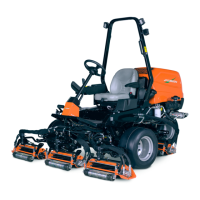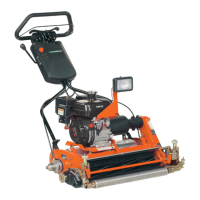5-24 673831-Rev A
HYDROSTATIC POWER TRAIN
5
Field Test Procedures
When a hydraulic system failure occurs, some simple
effective tests can be performed prior to using a test
instrument. The results of these tests can lead you to the
suspected component failure. More extensive test
procedures, using test instruments, are presented later in
this section. (See “Instrument Test Procedures” on
page 5-25.)
Preliminary Checks
Perform the following checks prior to beginning any tests.
1. Check the hydraulic oil reservoir for proper fluid level,
the presence of air or water, and unusual odor.
2. Check all lines and fittings for leaks. Tighten as
needed.
3. Eliminate all mechanical issues prior to starting
hydraulic tests.
Charge Pump Test
The charge pump supplies oil for charging the traction
circuit and traction pump.
If faults exist in the charge pump, proceed with an
instrument test for the charge pump. (See “Charge Pump
Test” on page 5-26.)
Traction System Test
See Figure 5-14.
• Be sure tow valve is closed before beginning traction
system test.
• The LDU will display a fault when the traction pedal is
pressed with the parking brake switch in the ON
position.
1. Operate hydraulic system until oil temperature is at
120–150° F (49–65° C).
2. Put the parking brake switch in the ON position.
Figure 5-14
3. Install wheel restraints (1) to all wheels.
4. Lower the cutting units and move throttle lever to full
throttle. Slowly push the traction pedal forward.
Does the engine labor or stall?
YES The hydrostatic drive train circuit is good.
NO The hydrostatic drive circuit is faulty.
Additional testing is required. Proceed to
instrument test. (See “Instrument Test
Procedures” on page 5-25.)

